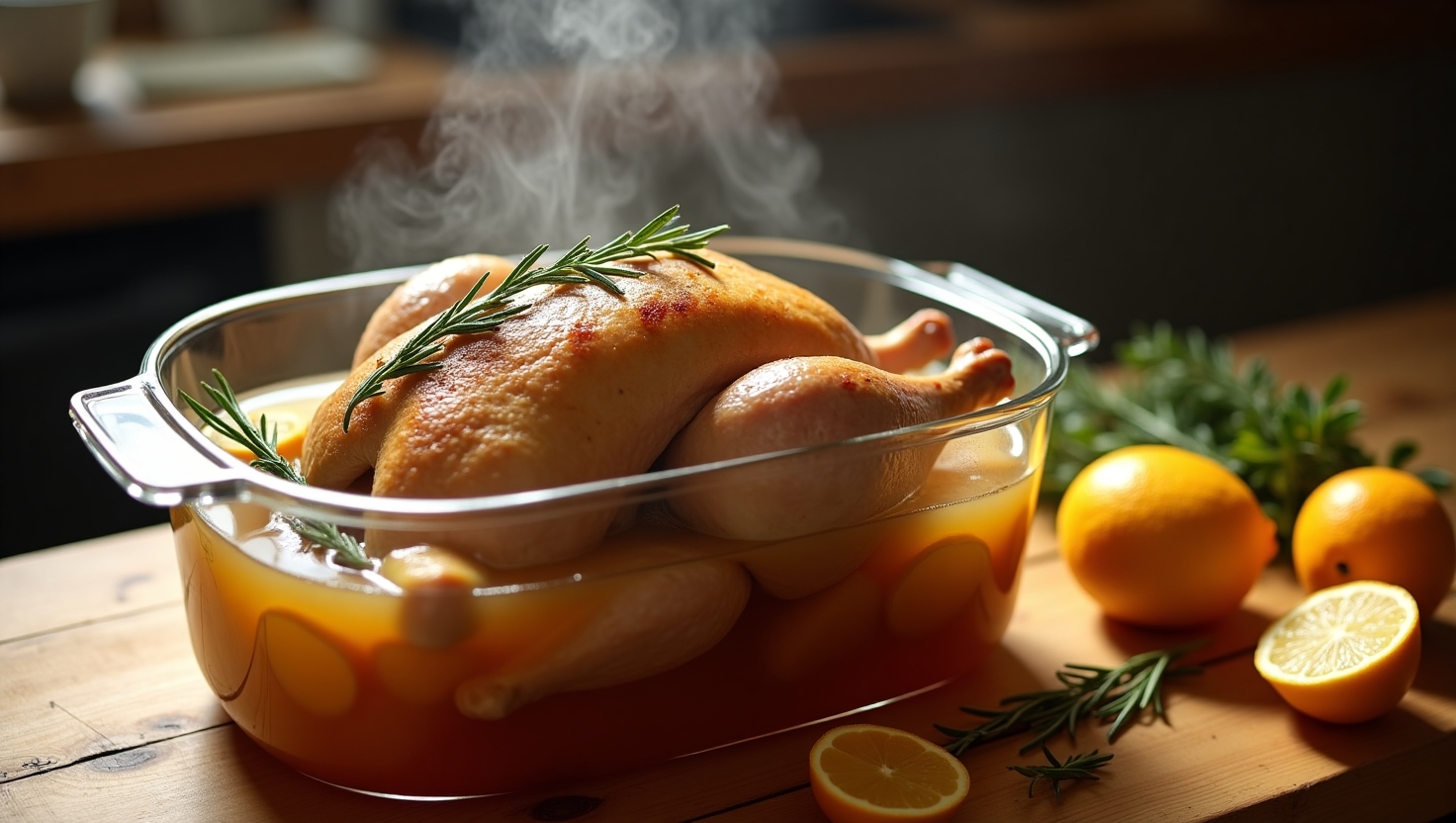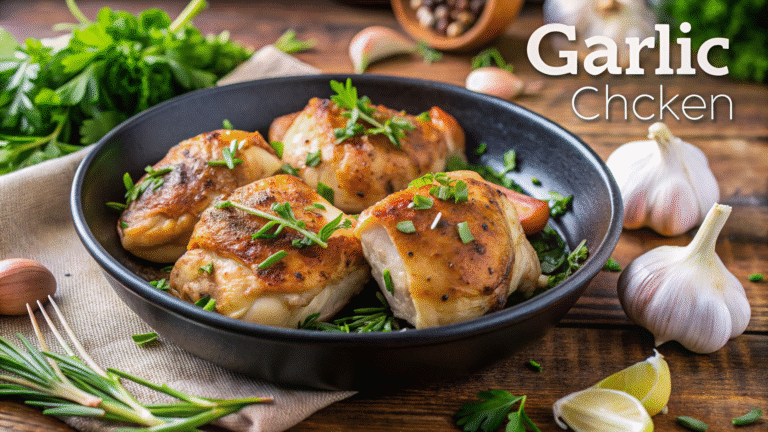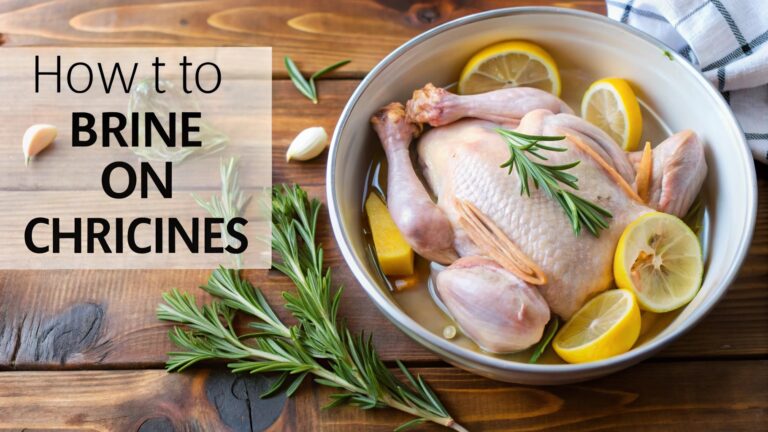Brining Chicken: How to Brine Faster with 2 Time Tricks

Imagine spending hours on a chicken dinner, only to find it dry when it comes out of the oven. This is a common problem. But, brining chicken could be the solution you’ve been looking for.
Brining chicken is more than just a trend. It’s a traditional method that makes ordinary chicken juicy and full of flavor. It’s a skill that can take your cooking to the next level, whether you’re a home cook or a chef.
Brining chicken makes every meal better, whether it’s for a backyard BBQ or a fancy dinner party. It’s easy to do and makes a big difference in taste and texture.
Key Takeaways
- Brining dramatically improves chicken moisture retention
- Simple technique suitable for home and professional cooks
- Enhances overall flavor and tenderness of chicken
- Works with multiple cooking methods
- Minimal additional preparation time required
What is Brining and How Does It Work?
Brining turns regular chicken into a delicious treat. It’s a secret way to make meat taste better and stay moist. You soak chicken in a salty water mix that works wonders.
Learning about brining shows why it’s key for cooking great chicken. It changes the meat’s cells through osmosis, making it special.
The Osmosis Magic
Salt does a few important things during brining:
- Breaks down protein structures
- Helps meat retain moisture
- Enhances natural flavor profiles
Salt’s Remarkable Role
Salt is a strong tenderizer and flavor booster. When chicken is in saltwater, several things happen:
| Process | Result |
|---|---|
| Protein Denaturation | Relaxes muscle fibers |
| Moisture Absorption | Increases water retention |
| Flavor Penetration | Distributes seasoning evenly |
“Brining is not just cooking—it’s culinary science in action.” – Professional Chef
Knowing these facts helps make your chicken dishes amazing. You’ll get juicy, tasty results every time.
Benefits of Brining Chicken: A Juicier Bite
Discovering the advantages of brining meat can change your cooking. Brining chicken makes your dishes more flavorful and moist. It’s a technique that boosts your cooking skills.
Brine chicken does more than just add flavor. It’s a scientific trick that makes meat tender and juicy. You’ll get great results every time you cook.
Retaining Moisture During Cooking
Brining chicken creates a shield against dryness. The salt solution keeps water in the meat while it cooks. This leads to:
- Up to 30% more moisture in your dish
- Less chance of overcooking
- Even texture in all chicken cuts
Enhancing Flavor and Seasoning Penetration
Brining is not just about keeping meat moist. It’s a flavor boost. The salt solution lets seasonings soak deeper into the meat. This gives you:
- Deeper flavor
- Even seasoning all through the meat
- Better natural chicken taste
Learning about brining can take your cooking to the next level. It will impress your family and friends.
Brining vs. Marinating: Key Differences
Choosing the right method for cooking chicken can greatly improve your dish. Brining and marinating are two different ways to add flavor and texture to your chicken.
Brining can turn simple chicken into a delicious meal. It goes deeper than marinating, which mainly adds flavor to the surface. Brining gets into the meat’s cells, making it more moist and flavorful.
What Sets Brining Apart
Brining stands out from marinating in several ways:
- Salt helps keep the meat moist
- It reaches deeper into the meat than marinades
- It makes the meat juicier by working with proteins
- It ensures the chicken is evenly seasoned
“Brining is like giving your chicken a flavor passport, allowing seasoning to travel everywhere.” – Professional Chef
When to Choose Brining Over Marinating
Brining is best for certain cooking situations:
- It’s great for lean meats that can dry out
- Perfect for roasting or grilling whole chickens
- It ensures every bite is seasoned the same
- It helps keep the chicken moist
While marinades add flavor to the surface, brining changes the chicken’s moisture and taste. Knowing these differences can improve your chicken cooking.
Types of Brining Techniques You Can Use
Learning how to brine chicken means knowing different techniques. These methods can make your cooking better. Whether you cook at home or are a food lover, trying out various brining ways will help you get juicy and flavorful chicken every time.
There are two main brining techniques: wet brining and dry brining. Each has its own benefits for making tasty chicken dishes.
Wet Brining: The Traditional Approach
Wet brining means putting chicken in a saltwater mix. This method helps:
- Keep the chicken moist
- Make the flavors go deeper
- Make the chicken tender
To wet brine, you need:
- A big container
- Kosher salt
- Water
- Optional herbs and spices
Dry Brining: A Modern Alternative
Dry brining is simpler. It involves rubbing salt on the chicken’s skin. This method needs less prep and can still make the meat juicy and tasty.
Here’s how to dry brine:
- Put a lot of salt on the chicken
- Let it sit uncovered in the fridge
- Let the salt pull out and then soak back moisture
Choosing the right brining method depends on your cooking style, how much time you have, and what flavor you want. Try both wet and dry brining to find your favorite way to cook delicious chicken.
Ingredients to Use in Your Brine Solution
Making a great brine for chicken is more than just salt and water. The right mix can turn simple chicken into a flavorful dish. Knowing what makes a good brine is key for both home cooks and chefs.
The salt you pick is very important in brining chicken. Different salts can change the taste and texture of your chicken a lot.
Essential Salt Types and Their Effects
- Kosher Salt: The top choice for brining, with big crystals that dissolve well
- Sea Salt: Adds mineral flavor and a bit of complexity
- Table Salt: It works, but skip iodized types to avoid a metallic taste
Flavor Boosters: Herbs and Spices
Add herbs and spices to your brine for amazing flavor. These ingredients make your chicken taste incredible.
| Herb/Spice | Flavor Profile | Best Used With |
|---|---|---|
| Rosemary | Woody, pine-like | Roasted or grilled chicken |
| Thyme | Earthy, slightly minty | Roasted whole chicken |
| Black Peppercorns | Sharp, warming | Any chicken preparation |
| Garlic | Pungent, robust | Grilled or roasted chicken |
Tip for brining chicken: Use fresh herbs if you can. Dried herbs are okay, but they pack more flavor. Try different mixes to find your favorite brine.
How Long Should You Brine Chicken?
Learning how to brine chicken is all about timing. It’s a process that can make your chicken taste amazing. The right timing is key to success.

The brining time depends on a few important factors. These factors affect the taste and texture of your chicken. Always aim to avoid too much salt while getting the most flavor.
General Brining Time Guidelines
Each chicken cut needs a specific brining time for the best results:
- Chicken breasts: 30 minutes to 2 hours
- Whole chicken: 8-12 hours
- Chicken thighs: 1-4 hours
- Chicken wings: 30 minutes to 1 hour
Size and Thickness Considerations
Thicker chicken cuts need longer brining times. Smaller, thinner pieces absorb salt quickly and can get too salty if brined too long. Adjust the brining time based on the chicken’s size and thickness.
Pro tip: Most home cooks find the best results with brining times between 1-4 hours. This balance ensures flavor and texture without over-salting.
The key is to experiment and find the perfect brining time that works for your specific recipe and taste preferences.
Common Mistakes to Avoid When Brining
Brining chicken can make your cooking better, but some mistakes can ruin it. Knowing how to brine well is key. It shows how important brining is for poultry.
Professional chefs say brining needs precision and care. Knowing what to avoid can greatly improve your cooking.
Over-Brining: When Too Much Salt Becomes a Problem
Brining chicken needs careful timing. If you leave it in the salt too long, you might get:
- Excessively salty meat
- Mushy texture
- Loss of natural chicken flavor
The secret to great brining is knowing the right duration for each chicken cut. Smaller pieces need less time than whole birds.
Proper Rinsing: A Critical Step in Brining
Always rinse your chicken well after brining. Not doing this can make your dish too salty.
- Rinse under cold water
- Pat dry with paper towels
- Allow chicken to rest before cooking
Following these tips will keep your poultry juicy and flavorful. The art of brining poultry is all about mastering these details.
Best Chicken Recipes Featuring Brining
Brining chicken recipes can make your cooking amazing. They add incredible flavor and moisture to your dishes. Whether you love grilling in summer or cozy meals in winter, brining offers tasty solutions.

Brining chicken does more than just add flavor. It keeps your meat juicy, tender, and full of taste, no matter how you cook it.
Grilled Brined Chicken: A Summer Culinary Adventure
Grilled brined chicken is the best of summer cooking. Your brining recipe ensures juicy results every time. Here’s how to make perfect grilled chicken:
- Prepare a basic salt water brine with herbs
- Soak chicken for 2-4 hours before grilling
- Pat dry and season with your favorite spices
- Grill over medium-high heat until internal temperature reaches 165°F
Oven-Roasted Brined Chicken: Comfort on a Plate
In cooler months, oven-roasted brined chicken is the ultimate comfort. Brining makes the chicken crispy outside and moist inside.
- Create a herb-infused wet brine
- Brine chicken for 4-6 hours
- Rinse and pat completely dry
- Roast at 425°F until golden brown
Pro tip: Always use kosher salt for the most effective brining results!
Conclusion: Ready to Brine Your Chicken?
Brining chicken changes the game, making ordinary poultry into amazing meals. It’s not just about seasoning. It’s a way to keep meat moist and add flavor. By learning brining, you can make your chicken juicy and tasty, impressing everyone.
Brining chicken has many benefits. It makes the meat tender and flavorful. This technique is easy to learn and can make any dish better. Whether you’re grilling or roasting, brining can elevate your cooking.
Start your brining journey with simple recipes. Try different salts and herbs. Each try will improve your skills and introduce new flavors. Remember, practice makes perfect, and small changes can make a big difference.
Final Thoughts on the Benefits of Brining
Make brining a key skill in your kitchen. It’s easy and can turn simple chicken into a gourmet dish. The world of brining is full of possibilities for you to explore.
Encouragement to Experiment with Brining
Be bold and add your own twist to brining. Every chef starts with basics and then adds their own flair. Your brining journey is just starting, and the possibilities are endless.







